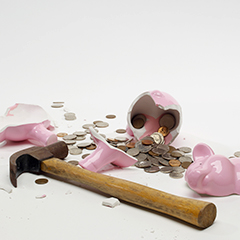Converting Future Damages to Present Value
May 19, 2015 | Valuations
 Small businesses may need a skilled valuation expert for several different reasons, but one of them is to calculate damages. A good valuator can discount future damages to present value, providing the ammunition businesses need to receive a just award.
Small businesses may need a skilled valuation expert for several different reasons, but one of them is to calculate damages. A good valuator can discount future damages to present value, providing the ammunition businesses need to receive a just award.
For illustration purposes, consider the following example. Say a company fires an employee for stealing trade secrets. The business enlists the courts help in recovering the lost profits it likely would have gained in the future if the employee had not given secrets to a competitor.
So what is the best way to configure lost profits?
It’s not an easy answer. But a skillful financial expert can discount future damages to present value, allowing the business to get a fair award.
Recognize the Impact
The difference between discounted and undiscounted damages awards can be substantial. However, many plaintiffs don’t recognize the impact that discounting can have. A defendant who doesn’t object to an undiscounted award may end up overpaying. Suppose that a plaintiff recovers damages for lost profits of $500,000 per year for five years. Without discounting, damages would total $2.5 million. But using a 10 percent discount rate could reduce that amount by more than $250,000.
Both parties must agree that the discount rate used is reasonable. Seemingly small rate variations can affect the damages amount significantly.
Understand What Affects the Discount Rate
The discount rate is the rate of return an investor would want, given the level of risk or uncertainty associated with the plaintiff’s profits and, specifically, with the probability those profits would materialize.
If the business has a history of consistent earnings and its risk of not meeting projected future earnings goals is low, a modest rate of return may be appropriate. But if it is in a high-risk industry or has volatile earnings, an investor would require a higher return to compensate for the risk.
Valuators have different ways of calculating a discount rate; each involves a risk factor analysis. The build-up method, for example, begins with a risk-free rate of return, which is usually the same yield as government bonds. The valuator would then increase that rate to reflect whatever risks are associated with the projected lost cash flows.
Know How to Approach Damages
Once they have a discount rate, financial experts can use two approaches to calculate lost profits damages. They can determine the plaintiff’s expected future income stream and then discount it to present value using a risk-adjusted discount rate. Or, they can also incorporate risk considerations into the future income projection and then reduce projected income to present value using a lower-risk discount rate.
The first approach may offer greater simplicity. But the second approach may be easier for a judge or jury to understand. It may be difficult to grasp how risk factors are used to modify the discount rate but is easy to comprehend the impact of risk on a plaintiff’s future earnings potential.
No Easy Task
Many plaintiffs simply don’t recognize the impact that discounting can have on damages awards. As a result, it’s critical that they retain a financial expert who understands the ins and outs of discounting future losses to present value. For more information, contact Filler & Associates.
